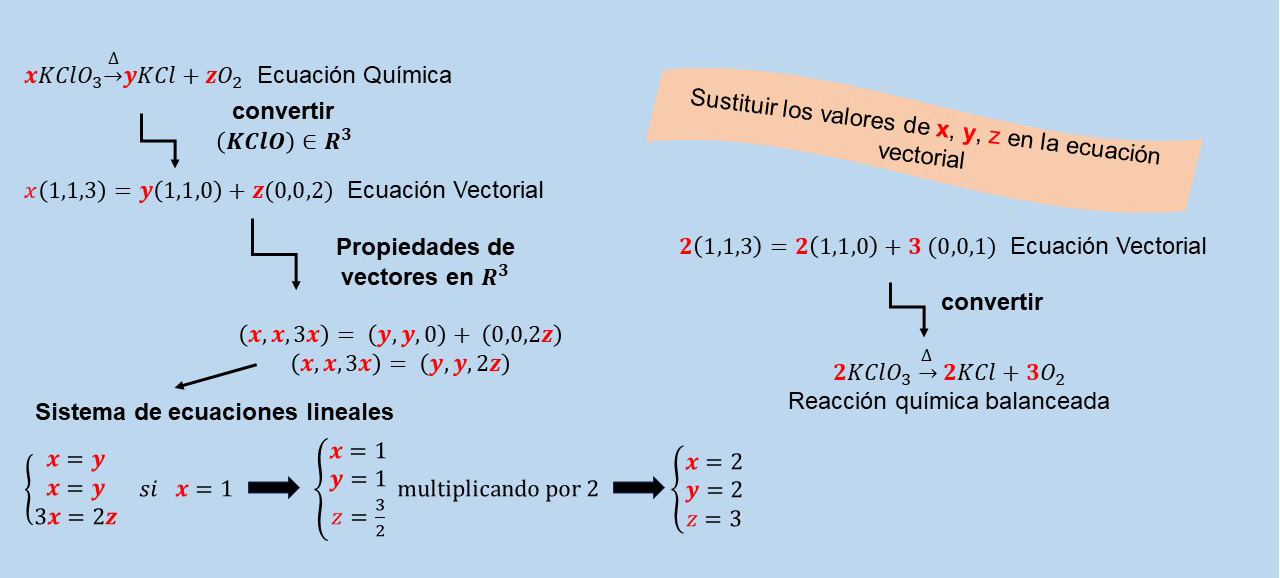Balancing chemical equations using properties of vectors in the three-dimensional space R3
Main Article Content
Abstract
In the teaching of chemistry in secondary education and at the university level, three methods are commonly used to understand the balancing of chemical reactions by simple inspection, algebraic and ion-electron. The objective of this study is to employ the properties of vectors in the three-dimensional space R3 for the adjustment of simple and complex charge-free chemical equations, without the use of software. The method is based on transforming a chemical equation into a vector equation, starting from the vector equation and using the properties of the vectors in R3, the stoichiometric coefficients are determined with simple and easy to solve systems of linear equations; satisfying the law of conservation of mass in the balancing of chemical reactions. The novelty of this method of balancing chemical equations is that the steps are practical and the mathematical foundation is not so complicated, so that it can be used as an alternative didactic resource for those students who find it difficult to understand the existing balancing methods.
Article Details
References
Altintas, B. (2022). Application of various matrix methods for balancing chemical equation by using R programming language as a tool. Research Square. 1,1-12. http://doi.org/10.21203/rs.3.rs-1994270/v1
Barrett, E. (2019) Using Matrices to Balance Chemical Reactions and Modeling the Implications of a Balanced Reaction. Undergraduate Journal of Mathematical Modeling. 10(5),1-20. https://doi.org/10.5038/2326-3652.10.1.4910
Chacón, D and Apte, S. (2023). A python code algorithm for balancing chemical equations as a system of simultaneous linear equations using matrix algebra. Journal of High School Science. 7(2), 1-9. https://jhss.scholasticahq.com/article/77360.pdf
Charnock, N.L. (2016). Teaching Method for Balancing Chemical Equations: An Inspection versus an Algebraic Approach. American Journal of Educational Research.4(7), 507-511. http://pubs.sciepub.com/education/4/7/2
Constales, D; Yablonsky, G.S and Marin, G.B. (2014). The C-matrix: Augmentation and reduction in the analysis of chemical composition and structure Chemical Engineering Science. 110,164–168. https://doi.org/10.1016/j.ces.2013.09.043
Croeau, J; Fox, W.P and Varazo, K. (2007). Mathematical modeling of chemical stoichiometry. Primus. 17(4), 301–315.
Glasser, L and Smith, W. (2019). Chemical Reaction Stoichiometry: A Key Link between Thermodynamics and Kinetics, and an Excel Implementation. ChemRxiv. 1,1-20. http://doi.org/10.26434/chemrxiv.7848179.v1
Guerrero, M. (2018). Modelo Matricial para el Balanceo de Ecuaciones Químicas. Mica. 1(1),48-60. https://docplayer.es/84717386-Modelo-matricial-para-el-balanceo-de-ecuaciones-quimicas-matrix-model-for-the-balance-of-chemical-equations- mario-guerrero-rodriguez.html.
Guo, C. (1997). A New and General Method for Balancing Chemical Equations by Inspections. Journal of Chemical Education. 74(11),1365-1366. http://doi.org/10.1021/ed074p1365
Herndon, W. C. (1997). On Balancing Chemical Equations: Past and Present. Journal of Chemical Education. 74 (11),1359-1362. http://doi.org/10.1021/ed074p1359
Hamid, I. (2019). Balancing Chemical Equations by Systems of Linear Equations. Applied Mathematics. 10(07), 521–526. http://doi.org/10.4236/am.2019.107036
Johar, D. A. (2020). Application of the Concept of Linear Equation Systems in Balancing Chemical Reaction Equations. International Journal of Global Operations Research. 1(4),130-135. https://doi.org/10.47194/ijgor.v1i4.48
Krishna, Y. H., Bindu, P., Yaragani, V., Vijaya, N., and Makinde, O. D. (2020). Application of Gauss-Jordan elimination method in balancing typical chemical equations. International Journal of Scientific & Technology Research, 8(1),465-468. https://www.academia.edu/download/78894058/-Application-Of-Gauss-jordan-Elimination-Method-In-Balancing-Typical-Chemical-Equations.pdf
Padmaja, V., Harikrishna, Y., and Ramana Reddy, G. V. (2017). An innovative approach of matrix algebra to balancing chemical-reaction equations. World of Journal of Pharmacy and Pharmaceutical Sciences, 6(3), 260-266. https://www.researchgate.net/publication/325754864_An_innovative_approach_of_matrix_algebra_to_balancing_chemical-reaction_equations
Porter, S. K. (1985). How should equation balancing be taught?. Journal of Chemical Education. 62(6)507-508. http://doi.org/10.1021/ed062p507
Regalado-Méndez, A., Delgado-Vidal, F. K., Martínez-López, R. E., & Peralta-Reyes, E. (2014). Balanceo de ecuaciones químicas integrando las asignaturas de química general, algebra lineal y computación: un enfoque de aprendizaje activo. Formación Universitaria. 7(2),29-39. https://www.redalyc.org/articulo.oa?id=373534462005
Shaikh, M. M., and Yousaf, M. (2023). On mathematical methods to balance equations of chemical reactions–a comparison and way forward. Journal of mechanics of continua and mathematical sciences. 18(1), 1-20. https://doi.org/10.26782/jmcms.2023.01.00001
Toth, Z. (1997). Balancing Chemical Equations by Inspection. Journal of Chemical Education. 77(11),1363. http://doi.otg/10.1021/ed074p1363
Val Castillo, O. (2023, julio-septiembre). Consideraciones didácticas sobre el ajuste de reacciones redox. Descripción de un método híbrido de ajuste. Educación Química, 34(3). https://doi.org/10.22201/fq.18708404e.2023.3.84161

Educación Química por Universidad Nacional Autónoma de México se distribuye bajo una Licencia Creative Commons Atribución-NoComercial-SinDerivar 4.0 Internacional.
Basada en una obra en http://www.revistas.unam.mx/index.php/req.
